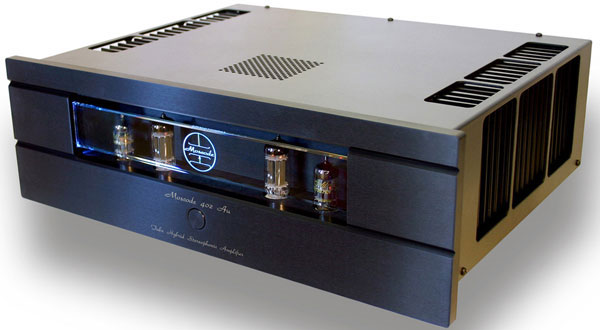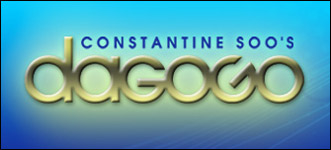Featured Article from
Doug Schroeder describes a progeny of OTL amplification: The $6,495 Moscode 402Au stereo power amplifier
Reviewer: Doug Schroeder
I recall being in a discussion years ago with a long time audio manufacturer who mentioned a person nicknamed “Gizmoâ€. I blanked, “Uh…,†while trying to cover my profound ignorance. Harvey “Gizmo†Rosenberg, the colorful owner of New York Audio Labs, made his mark as a manufacturer of Output Transformerless (OTL) audiophile amps. It was only after researching his name that I heard of his antics including delivering amps from NYAL to customers along with diapers! I do recall from long term memory having perused an audio magazine and seeing a picture of an enigmatic character wearing a kilt and tube headdress. At the time I had dismissed Harvey’s colorful antics as the actions of an audio show weirdo. That wasn’t the most astute conclusion to draw in regards to the man who helped Julius Futterman preserve the OTL design. I’m working hard hereto make up for it.
It is a good thing that personalities in audio are tied to recordings and equipment, so that those who discover new gear may also absorb some of the culture and history of audiophilia. Such it was that I was led to a greater appreciation of the electrical and “theatrical†aspects of amplifier design when I arranged for a review of the Moscode 402Au amplifier. In truth, it was not the journalistically opportunistic antics of “Dr. Gizmoâ€, the history of OTLs or the tenure of Moscode’s amp production that I held foremost in my mind as I emerged from a particular demonstration at CES 2009 – it was the sound of the amplifier. The Moscode 402Au struck me as one of the better sounding amps at the show, and thus became the impetus for this article.
The commemorative amplifier dedicated to Harvey Rosenberg was the 401HR. It’s rare that an amp memorializes an individual, but George Kaye has made sure via the 401HR that Harvey Rosenberg will not be forgotten. It seems Harvey pulled Futterman’s disheveled notes and ever changing models of amps together to preserve his work on the OTL. The amps had been made literally one at a time by Julius, never realizing a final form for production. Harvey, acquiring the rights to the OTL circuit, brought that to the equation after Julius’ death.
Harvey was keen on taking the OTL design one step further, by using MOSFETS in the output stage. A MOSFET, short for “metal oxide semiconductor field effect transistorâ€, is used to amplify or switch signals. George Kaye originated the Moscode’s tube+MOSFET concept, and he took it to Harvey of NYAL and took on the title as the NYAL chief engineer while further developing the concept. In other words, George and Gizmo took what were the strengths of the OTL and mated them to the strengths of a solid-state design. Thus born Moscode, a design utilizing triode tubes in coscode arrangement to control the signal being utilized by the MOSFET, resulting in a hybrid (“MOS†+ “codeâ€).
Ok, so it’s a hybrid amp – so what? One must remember that this was pretty radical thinking nearly 25 years ago in 1984! We don’t even look twice at hybrid cars, as they have become so common. A hybrid amp was anything but ordinary back then; it’s had incredible longevity and sonic merit to be implemented a quarter century later!
George is adamant about the fact that the Moscode 402Au is not just a tube gain stage slapped onto a solid-state power amplifier; rather, it is a tube amplifier with a MOSFET output stage. It’s obvious from the depth of the discussion in the Owner’s Manual that he wants people to appreciate the thoroughness of the design of the amp, not just its sound. For the three pages which comprise the discussion of the circuit the manual uses technical nomenclature, extolling the amp’s topology. Discussed is the fact that the tube driver stage and the MOSFET output stage are complimentary as both are high impedance devices. Further, the use of MOSFETs eliminate the need for Output Transformers, which George insists add unnecessary inductance and capacitance, “…and that,†states George, “interferes with the transfer function of the output transformer at high frequencies. They exhibit phase shift within the limits of the audio band.†This hinders them from revealing the maximum musical detail. MOSFETs, while not perfect, have power-related (harmonic distortion) as opposed to frequency response errors. George uses feedback to control for THD. His design rule, his “Rule of Tenâ€, is to, “Make the circuit work well to 10 times the highest or lowest frequencies it will handle…†A little overkill is a good thing!
Case in point, the “Au†in the name stands the use of gold plated, three-ounce circuit boards. These improve the musicality of the amplifier supposedly. The redesigned circuit layout offers advantages over the HR version (for Harvey Rosenberg) in the areas of lower noise pickup, clearer highs, tighter bass and better low-level detail.
All this extra attention to build quality reminds me of the garage on my first house, the ridge beam of which was bowed to the point of cracking. I was disgusted at the flimsy 1â€x8†which had been used. Over forty years it couldn’t take the weight of winter snowfalls. My solution was to overkill on the repair, so that it would never budge again. It was recommended that a 2â€x8†be used. I said, “Put a 2â€x12†in there,†and they did. When the contractor was finished he smiled, “You could put a VW on top of that roof!†Good! Ten years later, whenever I drive by the old house I look at that garage roof line – it’s still straight as an arrow! I think George feels the same way about building amps which will last.
George continues his tutorial in the manual on the topic of developing a robustpower supply. The goal is to simulate infinite power reserves. As a junkie of high-output amplifier, that sounds very good to me! The amps are to act as if normal power line fluctuations do not exist, accomplished by way of voltage regulation. According to the manual, “Voltage regulation eliminates interaction between the driver and power output stages.†Neither stage can influence the other unduly in terms of demand. Consequently, there is no need for power conditioning when using the 402Au.George intones, “A well designed power supply doesn’t need any help.†The amp stores 88,000mF of capacitance per channel, as well as sporting dual-mono supplies for each of the output stages. I like the fact that the heavy-duty power transformers are specified for 50Hz rather than 60Hz, “…to get more iron into the power supply.†Sounds like a discussion of a Harley Davidson; bigger, beefier is often a good thing – in cycles and amps.
| more… | page 2… |
| Specs: |
| Power: 200Wpc at 8 Ohms: 200; 4 ohms: 300+, both channels operating THD at full output: (tube dependent) with 6H30pi for V101 & 201, 0.15% or less at full power. Noise (inputs shorted): < 1mv Voltage Gain: (tube dependent) approx. 30-33 db. Tube Complement: • Choice of 6H30Pi, 6GU7, 6DJ8, 6922, 6FQ7, 5814, 7730, or 12AU7 • (2 each) 6H30Pi, 6GU7 supplied • Must be same tube types in “mirrored†positions • Inner tube pairs must be same type • Outer pairs must be same type Power Requirements: Wattage idle: approx 120W (1 amp); Watts at full output: approx 960 (8 amps) Available for 120V (USA), 230-240V (European), and 100V (Japan) Dimensions: Chassis W: 17 1/2″, D: 14 1/2″, H: 6 1/4″ Faceplate width: 19″ Shipping Weight: Approx 52 lbs Connections Input: Cardas Gold RCA, unbalanced, 100K input impedance Output: Edison Price Music Posts Standard Power: IEC standard connector Edge-Lit Logo Colors: • Dimmed: Always on/power is being supplied to the amplifier • Flashing: Warm-up cycle in progress (~ 45 seconds) • Red: Overheat condition/amplifier shuts down • During normal operation logo brightness is user controlled by a dimmer on the rear panelMSRP:$6,495 includes shipping in continental US/CanadaManufacturer:Moscode, Inc. 74 Cotton Mill Hill A124 Brattleboro, VT 05301URL: www.Moscode.com E-mail: info@Moscode.com 1-877-797-8823 |
| About Dagogo.com |
| DAGOGO (pronounced “dah-go-go”) is a U.S. high-end audio review monthly e-magazine established since November 2003. Its mission is to present both a macroscopic and microscopic view of the high-end audio hobby to its readers. Its contents include critical commentaries, industry personality interviews, specialty show coverages and music reviews. New articles are published on the 1st and 16th of every month. www.dagogo.com |










The Moscode 402Au. I got to find dealer in Norway, so I can test it whit my Jamo R907 and esoteric sacd player, because what I have read about 402Au it vill sounds like heaven+++
heaven – well Ivan – when you find it invite me over – cause that certainly can’t be missed!
Hi Ivan and Adam,
I would like to get you in touch with an importer. Please go to http://WWW.Moscode.com and send me an email. I’m happy to answer any questions you have.
Yours Truly,
George
I loved the original Moscode back in the 80′s .traded it in years later .would I buy it back ? YES